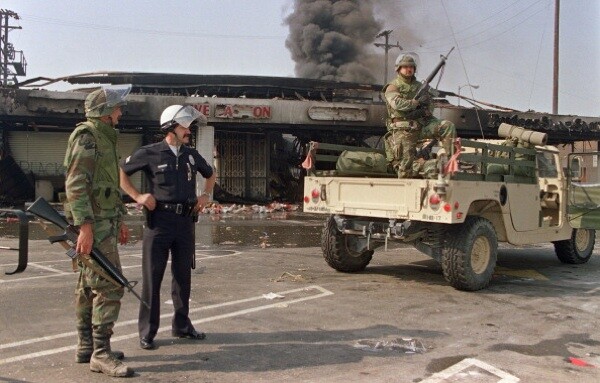Quiet Riot: Changes, or the Lack Thereof, Since L.A.'s Upheaval in April 1992

It's that time of the millennium. April is bearing down upon us, and with it the twentieth anniversary of April 29, 1992.
You remember that, yes? That was the day that the unrest/riots/rebellion (what you call it depends on your political stripe and/or general worldview) erupted here after the four cops who beat black motorist Rodney G. King were acquitted by an all-white jury in the criminal trial of the beating. In a progression of events remarkably similar to what had happened in Watts in 1965 twenty-seven years earlier, black L.A. boiled over with anger about yet another unsatisfactorily resolved case of police abuse directed at a black man, and took to the streets.
This time, though, unlike Watts, blacks had plenty of company: whites and Latinos were among those who attacked Parker Center, the LAPD downtown headquarters, and just about everybody joined in the looting that followed the burning. Geographically, the riots also spread out much farther and wider this time, reaching as far north as Hollywood. Yet the root causes of the eruption were the same as '65: a perceived lack of racial justice that included (but was hardly limited to) a color-coded criminal justice system and ongoing economic inequality most obviously represented by a merchant class in South Central that was not largely black, but Korean (in '65 that class was largely white and Jewish).
Nearly twenty years later, such myriad and complex systemic issues have receded into time and left us with--what? That's what I was pondering on Tuesday as I stood in Leimert Park with a film crew from a French television station that's doing a special on the twenty-year anniversary of whatever the French call the L.A. event. I'm not surprised that the French, or anyone other than American, jumped on this early; the story of what happened in 1992 was never really explored at the time, and will almost certainly not be explored next month. Really, how could it be otherwise? Twenty years ago the whole thing was quickly reduced to its video-game visuals: fires, angry faces, clashes between rioters and law enforcement that included the National Guard. The face-off in the public's mind was between marauding blacks and innocent Korean shopkeepers, and in one horrific incident that appeared to avenge Rodney King, marauding blacks and an innocent white truck driver named Reginald Denny, who was nearly beaten to death near Florence and Normandie Avenues.
Underneath the mayhem that became the riot's face, the sociopolitical paradigm of black and white didn't change at all; in fact, it was reinforced. Black discontent was viewed by much of L.A. and the rest of the conservative-leaning country as random, dangerous and politically unjustified, something to be avoided and contained rather than addressed. Certainly it was not a problem to be collectively solved. Despite a brief period of civic soul-searching, that view prevailed, and the result is that South Central, including its western tip of Leimert, has changed very little, while the rest of the city has moved on. Suffice it to say we've had negative gains.
The French broadcasters were eager to know many things--what lessons had been learned, what was going to be done now, what's coming next, what does "redevelopment" ultimately mean? I had lots of conjecture and comments, but very few answers.
Journalist and op-ed columnist Erin Aubry Kaplan's first-person accounts of politics and identity in Los Angeles, with an eye towards the city's African American community, appear every Thursday on KCET's SoCal Focus blog. Read all her posts here.


